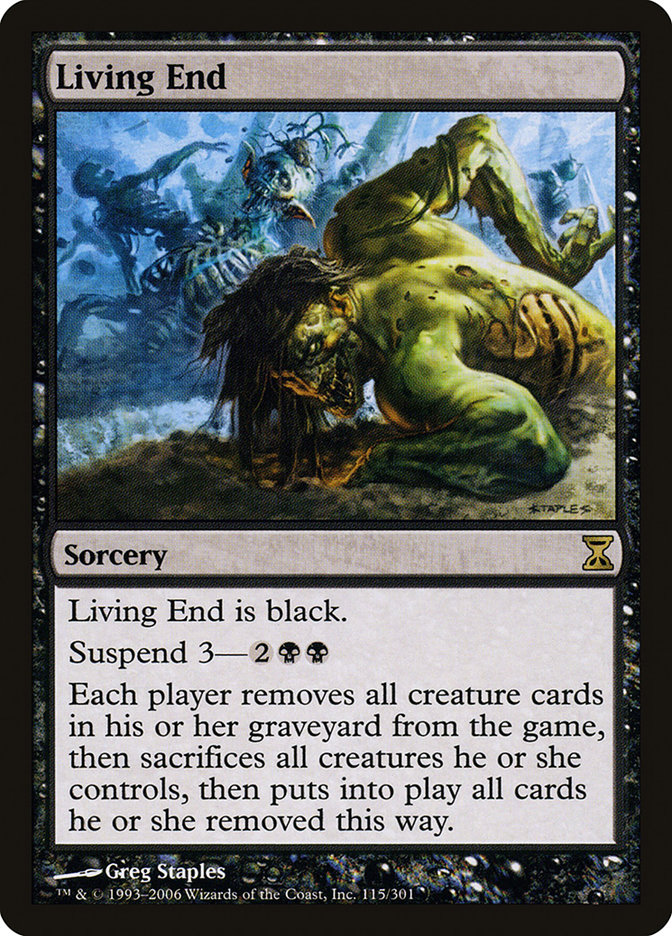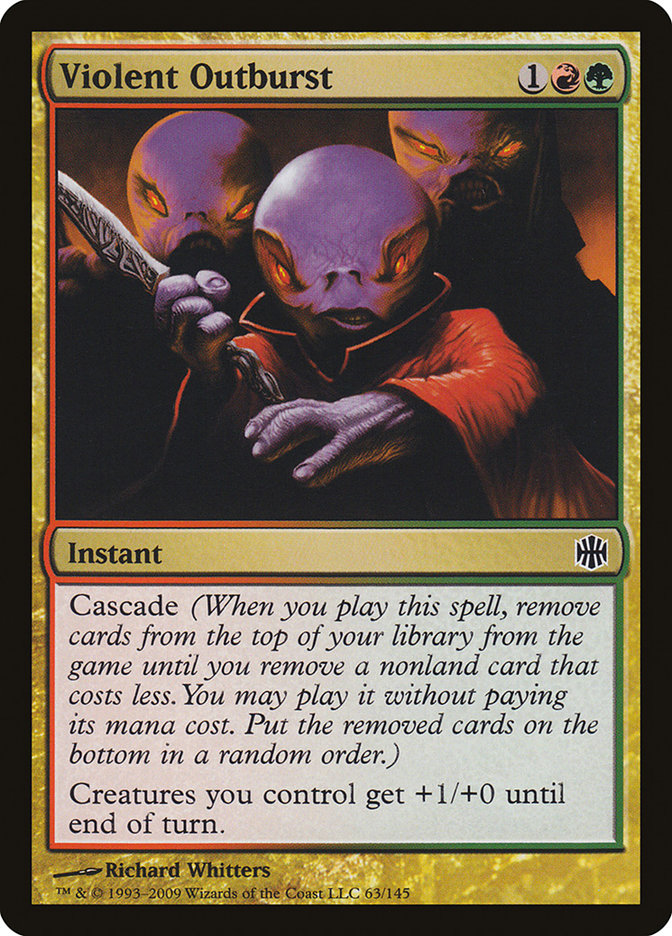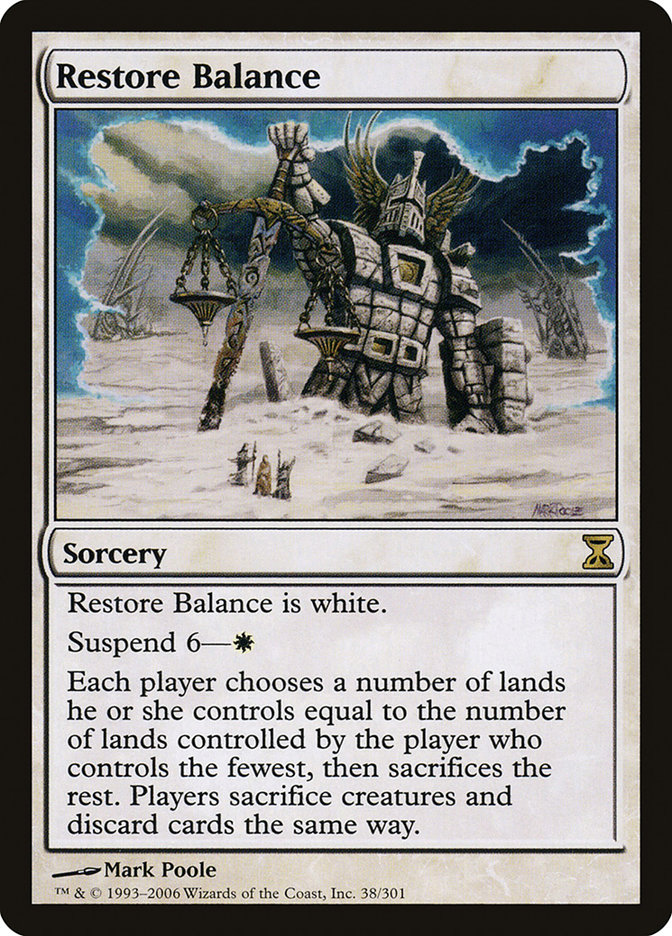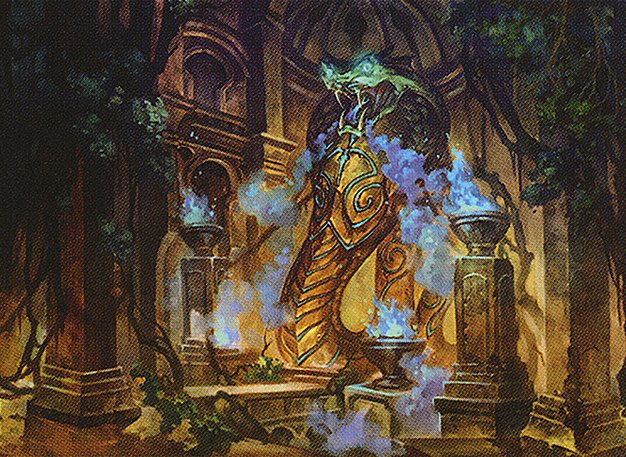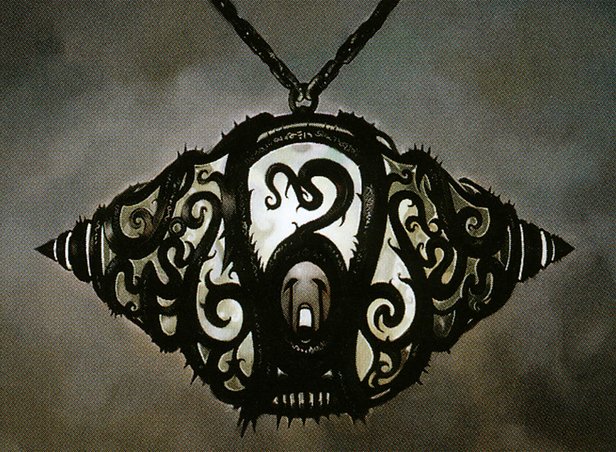Living End MTG Card
| Card sets | Released in 2 setsSee all |
| Rarity | Rare |
| Type | Sorcery |
| Abilities | Suspend |
Key Takeaways
- Grants unique card advantage by reanimating creatures, drastically shifting board state.
- Enables sudden tempo swings though not direct mana acceleration, impacting gameplay.
- Utilizes a cascade strategy for unpredictability and instant-speed play flexibility.
Text of card
Living End is black. Suspend 3— Each player removes all creature cards in his or her graveyard from the game, then sacrifices all creatures he or she controls, then puts into play all cards he or she removed this way.
Card Pros
Card Advantage: Living End is designed to skew the usual dynamics of a game by simultaneously acting as a board wipe and graveyard reanimation tool. It flips the script on resource management, giving players a unique form of card advantage by bringing creatures from the graveyard directly into play, often resulting in sudden shifts in board presence.
Resource Acceleration: While not directly accelerating resources in the conventional sense through mana production, Living End circumvents this by enabling a massive and often decisive tempo swing. Reanimating a full graveyard into a new, formidable army can equate to a rapid acceleration in terms of creature resources on the battlefield.
Instant Speed: As a card with suspend, Living End doesn’t have instant speed itself but is typically cast for free after its suspend time elapses. However, the strategy most often employed with it involves cascading into it using other spells at instant speed, allowing players to be responsive and flexible, catching opponents off guard outside the normal sequence of turns.
Card Cons
Discard Requirement: Playing Living End demands that you first cycle or discard cards, which can potentially deplete valuable hand resources, leaving you in a precarious position should the spell be countered or your graveyard be exiled.
Specific Mana Cost: Living End’s cascade mechanism requires you to play spells with a higher mana cost to avoid accidentally triggering unwanted cascades, thus restricting the spectrum of spells used in your deck building.
Comparatively High Mana Cost: Despite being cast through cascade, Living End effectively has a high alternative mana cost due to the necessity of playing costly cards for a reliable set off. This requirement can contribute to a slower pace in establishing your board presence.
Reasons to Include Living End in Your Collection
Versatility: Living End stands out because of its unique ability to act as a game-changer. It’s not just a card for a single deck archetype but can be a centerpiece in various cycling and graveyard-based decks. Its power to overhaul the battlefield makes it useful in multiple game situations.
Combo Potential: This card is infamous for its explosiveness when paired with cascade mechanics, allowing players to set off Living End unexpectedly and swing games in their favor. Its potential to resurrect a whole army at once makes it a linchpin in combo decks focused on massive waves of creatures.
Meta-Relevance: In an evolving competitive scene, Living End maintains its relevance. It’s a force against decks packed with creature removals, as it swiftly restores your board presence. As the meta shifts, Living End consistently offers players a route to overcome creature-heavy strategies and maintain a competitive edge.
How to beat
Living End is a unique card in MTG, known for its ability to completely turn the tide of a match by resurrecting creatures from the graveyard en masse. This powerful spell is cast using the cascade mechanic, bypassing its traditional suspend requirement. While its effect is undoubtedly game-changing, there are effective strategies to counter it and maintain control of the game.
To successfully navigate against Living End, graveyard hate cards can be particularly useful. By incorporating cards like Tormod’s Crypt or Leyline of the Void, you can remove creatures from your opponent’s graveyard and render Living End ineffective. Additionally, making use of counterspells such as Counterspell or Negate can help to stop Living End as it is being cascaded into. Alternatively, instant-speed removal spells that exile, like Path to Exile, may provide a means to immediately handle creatures resurrected by Living End before they can assert dominance over the battlefield.
Anticipating and pre-empting your opponent’s actions are key. By planning around their cascade triggers and keeping graveyard-controlling cards at the ready, you can reduce the impact of Living End, preserve your board state, and maintain your path to victory in MTG matches.
Cards like Living End
Living End is an intriguing card that has shaped its own unique archetype within Magic: The Gathering. It’s often likened to spells like Violent Outburst because of the cascade mechanic that ultimately lets you cast Living End without paying its mana cost. Violent Outburst affords you an instant-speed advantage, but doesn’t itself alter the board like Living End does.
Another comparable card is Ancestral Vision, which also lacks mana symbols and cannot be cast traditionally. While Ancestral Vision focuses on card draw, Living End dramatically swings the game by destroying all creatures on the battlefield and resurrecting all creatures from graveyards. Then there’s Restore Balance, which is similar to Living End in that it can be cast through cascade, profoundly affecting each game aspect by balancing lands, creatures, and cards in hand.
Evaluating the impact of these spells, Living End emerges as a pivotal card for players aiming to leverage their graveyard as a resource, while completely disrupting opponent’s board state. It carves out a distinctive role in MTG, making it a cornerstone for decks built around this grand strategy of cycling creatures and mass reanimation.
Cards similar to Living End by color, type and mana cost
Where to buy
If you're looking to purchase Living End MTG card by a specific set like Time Spiral and Time Spiral Remastered, there are several reliable options to consider. One of the primary sources is your local game store, where you can often find booster packs, individual cards, and preconstructed decks from current and some past sets. They often offer the added benefit of a community where you can trade with other players.
For a broader inventory, particularly of older sets, online marketplaces like TCGPlayer, Card Kingdom and Card Market offer extensive selections and allow you to search for cards from specific sets. Larger e-commerce platforms like eBay and Amazon also have listings from various sellers, which can be a good place to look for sealed product and rare finds.
Additionally, Magic’s official site often has a store locator and retailer lists for finding Wizards of the Coast licensed products. Remember to check for authenticity and the condition of the cards when purchasing, especially from individual sellers on larger marketplaces.
Below is a list of some store websites where you can buy the Living End and other MTG cards:
- eBay
- TCG Player
- Card Kingdom
- Card Market
- Star City Games
- CoolStuffInc
- MTG Mint Card
- Hareruya
- Troll and Toad
- ABU Games
- Card Hoarder Magic Online
- MTGO Traders Magic Online
See MTG Products
Printings
The Living End Magic the Gathering card was released in 2 different sets between 2006-10-06 and 2021-03-19. Illustrated by Greg Staples.
| # | Released | Name | Code | Symbol | Number | Frame | Layout | Border | Artist |
|---|---|---|---|---|---|---|---|---|---|
| 1 | 2006-10-06 | Time Spiral | TSP | 115 | 2003 | Normal | Black | Greg Staples | |
| 2 | 2021-03-19 | Time Spiral Remastered | TSR | 121 | 2015 | Normal | Black | Greg Staples |
Legalities
Magic the Gathering formats where Living End has restrictions
| Format | Legality |
|---|---|
| Commander | Legal |
| Legacy | Legal |
| Modern | Legal |
| Oathbreaker | Legal |
| Vintage | Legal |
| Duel | Legal |
| Predh | Legal |
Rules and information
The reference guide for Magic: The Gathering Living End card rulings provides official rulings, any errata issued, as well as a record of all the functional modifications that have occurred.
| Date | Text |
|---|---|
| 2013-06-07 | Although originally printed with a characteristic-defining ability that defined its color, this card now has a color indicator. This color indicator can’t be affected by text-changing effects (such as the one created by Crystal Spray), although color-changing effects can still overwrite it. |
| 2021-03-19 | While Living End is resolving, first each player exiles their graveyard at the same time, then each player sacrifices all creatures they control at the same time, and finally each player puts their exiled cards onto the battlefield at the same time. |
| 2021-03-19 | “All cards they exiled this way” refers only to the cards exiled in the first part of the effect. If a replacement effect (such as that of Leyline of the Void) exiles any of the sacrificed creatures instead of putting them into the graveyard, those cards aren’t returned to the battlefield. |
| 2021-06-18 | A card with no mana cost can’t be cast normally; you’ll need a way to cast it for an alternative cost or without paying its mana cost, such as by suspending it. |
| 2021-06-18 | As the second triggered ability resolves, you must cast the card if able. You must do so even if it requires targets and the only legal targets are ones that you really don’t want to target. Timing permissions based on the card’s type are ignored. |
| 2021-06-18 | Cards exiled with suspend are exiled face up. |
| 2021-06-18 | Exiling a card with suspend isn’t casting that card. This action doesn’t use the stack and can’t be responded to. |
| 2021-06-18 | If a card with no mana cost is given an alternative cost equal to its mana cost (by Snapcaster Mage, for example), that cost cannot be paid and the card cannot be cast this way. |
| 2021-06-18 | If an effect refers to a “suspended card,” that means a card that (1) has suspend, (2) is in exile, and (3) has one or more time counters on it. |
| 2021-06-18 | If the card has in its mana cost, you must choose 0 as the value of X when casting it without paying its mana cost. |
| 2021-06-18 | If the first triggered ability of suspend (the one that removes time counters) is countered, no time counter is removed. The ability will trigger again at the beginning of the card’s owner’s next upkeep. |
| 2021-06-18 | If the second triggered ability is countered, the card can’t be cast. It remains exiled with no time counters on it, and it’s no longer suspended. |
| 2021-06-18 | If the spell requires any targets, those targets are chosen when the spell is finally cast, not when it’s exiled. |
| 2021-06-18 | If you can’t cast the card, perhaps because there are no legal targets available, it remains exiled with no time counters on it, and it’s no longer suspended. |
| 2021-06-18 | If you cast a card “without paying its mana cost,” such as with suspend, you can’t choose to cast it for any alternative costs. You can, however, pay additional costs. If the card has any mandatory additional costs, you must pay those if you want to cast the card. |
| 2021-06-18 | Suspend is a keyword that represents three abilities. The first is a static ability that allows you to exile the card from your hand with the specified number of time counters (the number before the dash) on it by paying its suspend cost (listed after the dash). The second is a triggered ability that removes a time counter from the suspended card at the beginning of each of your upkeeps. The third is a triggered ability that causes you to cast the card when the last time counter is removed. If you cast a creature spell this way, it gains haste until you lose control of that creature (or, in rare cases, you lose control of the creature spell while it’s on the stack). |
| 2021-06-18 | The mana value of a spell cast without paying its mana cost is determined by its mana cost, even though that cost wasn’t paid. |
| 2021-06-18 | When the last time counter is removed, the second triggered ability of suspend (the one that lets you cast the card) triggers. It doesn’t matter why the last time counter was removed or what effect removed it. |
| 2021-06-18 | You are never forced to activate mana abilities to pay costs, so if there is a mandatory additional mana cost (such as from Thalia, Guardian of Thraben), you can decline to activate mana abilities to pay for it and hence fail to cast the suspended card, leaving it in exile. |
| 2021-06-18 | You can exile a card in your hand using suspend any time you could cast that card. Consider its card type, any effects that modify when you could cast it (such as flash) and any other effects that stop you from casting it (such as from Meddling Mage’s ability) to determine if and when you can do this. Whether you could actually complete all steps in casting the card is irrelevant. For example, you can exile a card with suspend that has no mana cost or that requires a target even if no legal targets are available at that time. |
